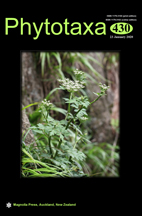Abstract
Androlepis najarroi (Bromelioideae, Bromeliaceae), a third dioecious species identified in the subfamily, is proposed as new from the Chiapas Highlands and Veracruzan biogeographical provinces, southern Megamexico. The novelty is superficially similar to Aechmea lueddemanniana but features characteristics of Androlepis, such as unisexual flowers and apically divided filaments. Based upon available information on the species and current generic concepts, assigning this species to Androlepis might only be provisional. The present contribution includes distribution maps, iconography, an identification key to the species of Androlepis, and a preliminary evaluation of the conservation status of this new species.

